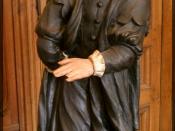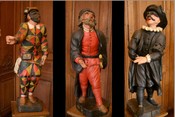Commedia Dell'Arte (1400-1600 AD)
1.)Commedia dell'Arte was essentially the first improvisational drama.
The Commedia dell'Arte was popular in 16th and 17th century Italy, in a period when theatre plays were classic and cold, and amateur actors recited their memorized lines onstage with no apparent emotion. Commedia dell'Arte - in English, "Artistic Comedy" or "Play of Professional Artists" - was the exact opposite: loud, colorful plays using stock characters (culturally stereotyped caricatures which appeared in every play). These stock characters, wearing distinctive masks pertaining to their character, would act out scenes on pre-planned subjects like adultery, jealousy, old age, or love, while improvising the text. It was a sort of slap-stick comedy, employing a great deal of exaggeration and physical humour.
The actors, unusually for Renaissance Europe, were much more than just dramatists. They were also acrobats, dancers, musicians, orators, quick thinkers, improvisators, and even psychologists, possessing a thorough knowledge of human nature.
They often interacted with the audience, suiting the comedy to the tastes of the crowd. If people of the upper classes were in the audience, the comedy was wittier and more insightful. On the other hand, if the audience was more middle and lower class, the play was more lewd.
Most Commedia troupes performed outdoors in town squares on stages which they brought with them in carts, along with their equipment, props, costumes, curtains, and ladders. The stages were usually built up to 2 meters high so that spectators had an unobstructed view of the play. This also allowed for a spacious storage area and change room underneath. Some of the better Commedia troupes performed in actual Renaissance theatres such as Palladio's theatre in Vicenza or the Petit Bourbon in France.
. 2.) a.) A stock character is a fictional character that relies heavily on cultural...


